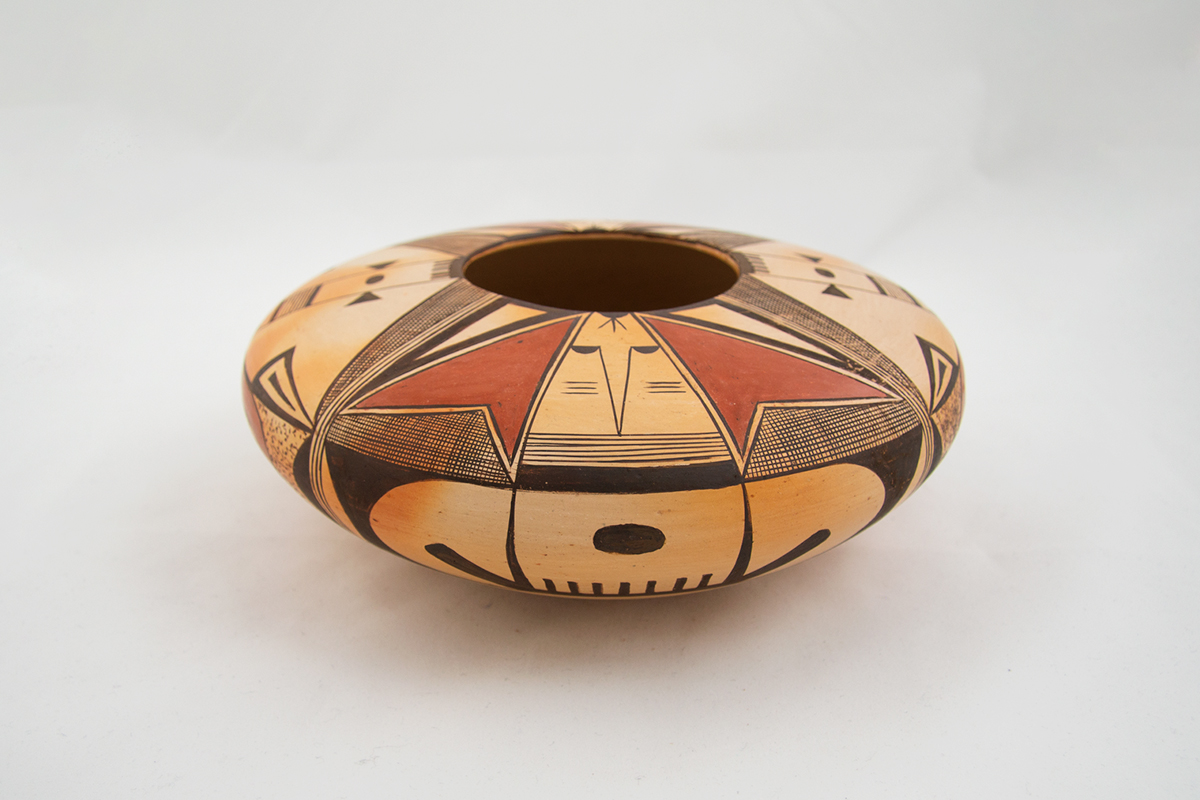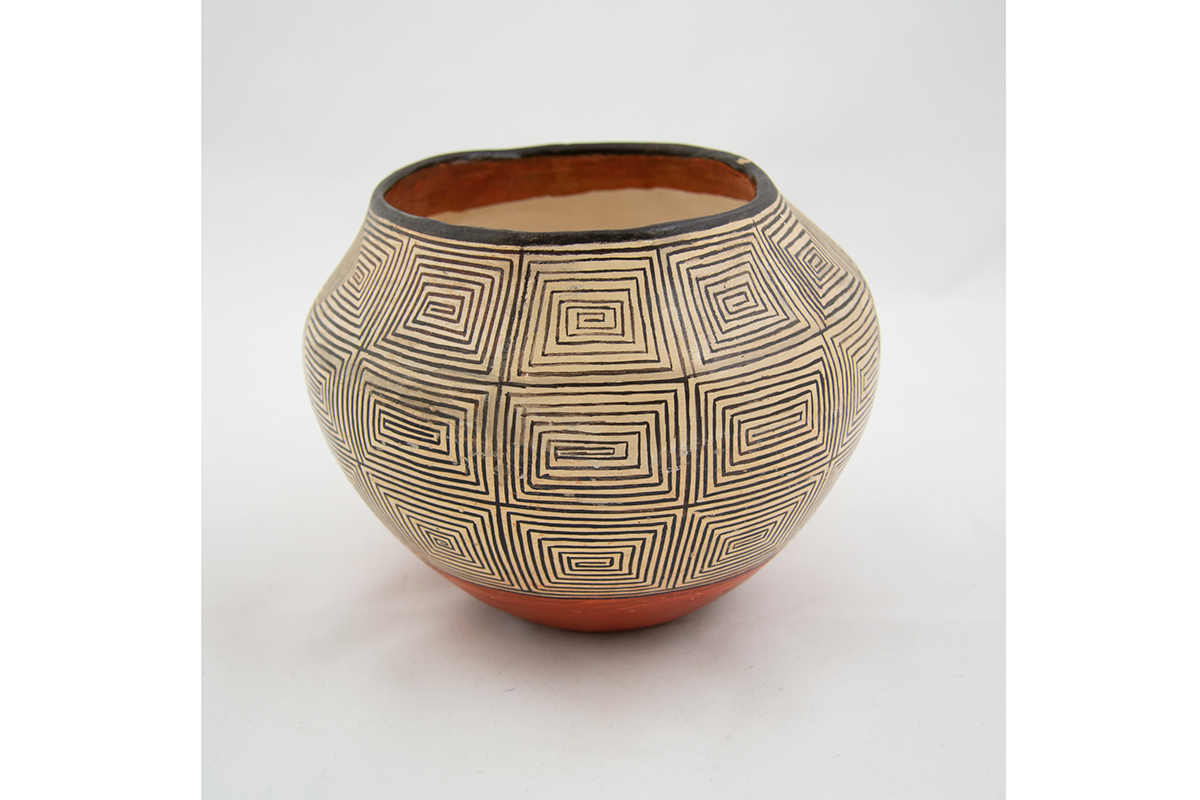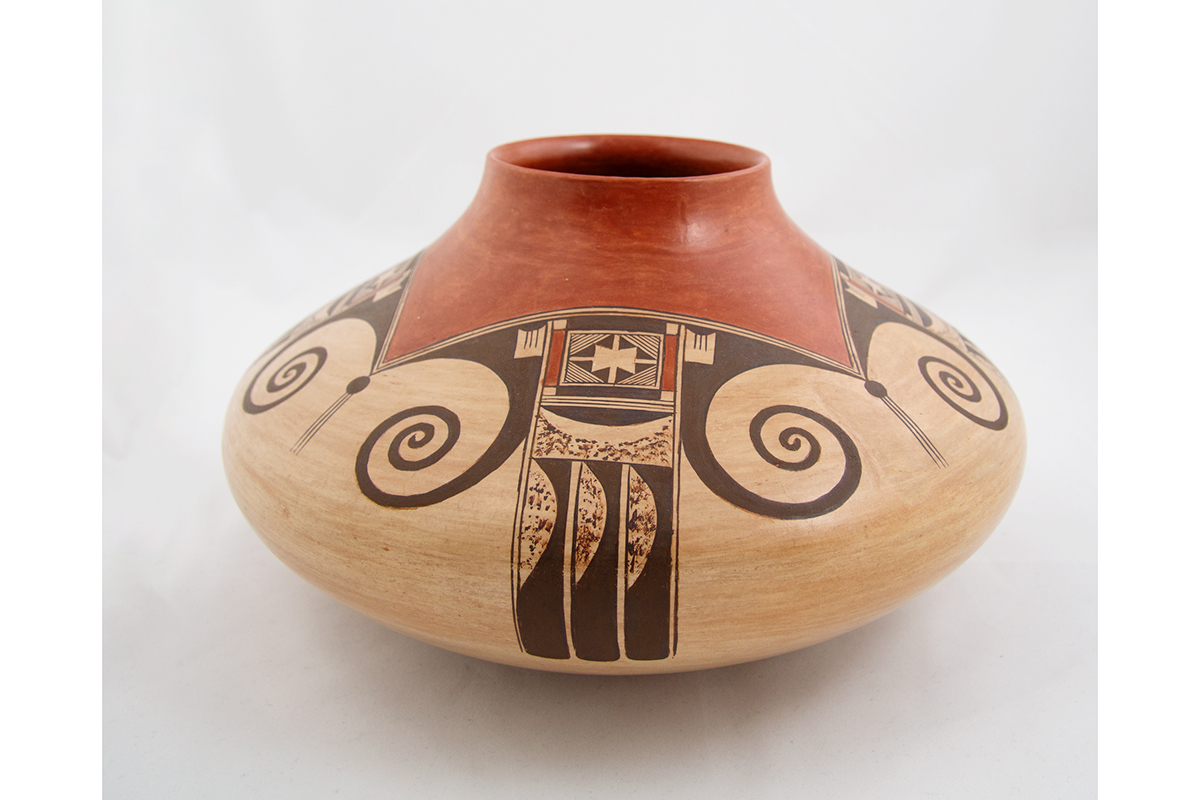
A new exhibition of Pueblo pottery at Krannert Art Museum illustrates the expertise of women potters and how the creation of ceramics connects them to their ancestral land and their communities.
Dextra Quotskuyva Nampeyo (Hopi-Tewa, Hopi Pueblo, Arizona, United States; 1928-2019), Polychrome Bowl, mid 20th c. Ceramic. George Ogura Collection, Gift of Shozo Sato and Mrs. Alice Ogura Sato for the late Dr. George I. Ogura. 2020-8-6 © Dextra Quotskuyva Nampeyo
Courtesy Krannert Art Museum
CHAMPAIGN, Ill. — An exhibition of Pueblo pots at Krannert Art Museum illustrates the expertise of women potters and how creating ceramics connects them with the past and present.
"To Know the Fire: Pueblo Women Potters and the Shaping of History" features earthenware vessels made by Pueblo communities in the Southwest. The exhibition is on view through Sept. 3.
Most of the approximately 90 pots in the exhibition are from the collection of the late George I. Ogura, donated to KAM in 2020. They represent the work of women from renowned pottery lineages who made them between the 1950s and 1980s.
"These works are exceptional in terms of technique and surface design," said Allyson Purpura, the curator of the exhibition and KAM's curator of global African art. "I wanted to stress the extraordinary skill of these women in translating two-dimensional designs on a three-dimensional form, creating repeating motifs that take direction from the contours of the vessels."

Lucy M. Lewis (Acoma, Acoma Pueblo, New Mexico, United States; 1898-1992), Black-on-white-Fineline Jar, 20th c. Ceramic. George Ogura Collection, Gift of Shozo Sato and Mrs. Alice Ogura Sato for the late Dr. George I. Ogura. 2020-8-15 © Lucy M. Lewis
Courtesy Krannert Art Museum
Pueblo potters saw the creation of vessels as a way to connect both to their ancestral land and to their community, Purpura said. The clay they used often included old pottery shards that were ground to a fine powder and mixed in, maintaining a direct connection to ancestral pots. The process of producing the vessels was social and collaborative – from preparing the clay; to scraping, polishing and painting the pots; to firing them.
Additionally, producing the works for sale allowed women to financially support their families and communities. Women began making pots for the tourist market in the late 19th century, when surveyors and archaeologists were excavating ancestral Pueblo sites, the Santa Fe Railroad was being built and trading posts were set up, Purpura said.
"What the women were doing was extraordinary. They were able to maintain traditional lifeways and were keepers of knowledge, while also earning money for their families. It's not just about the artistic excellence of the works, but also about how important art production was to community well-being," Purpura said.

Dextra Quotskuyva Nampeyo (Hopi-Tewa, Hopi Pueblo, Arizona, United States; 1928-2019), Polychrome Jar, mid to late 20th c. Ceramic. George Ogura Collection, Gift of Shozo Sato and Mrs. Alice Ogura Sato for the late Dr. George I. Ogura. 2020-8-11 © Dextra Quotskuyva Nampeyo
Courtesy Krannert Art Museum
The women were inspired by the designs on ancestral pottery shards excavated from abandoned pueblos and by the work of the multiple generations of artists in a family pottery lineage, creating their own interpretations of the motifs. For instance, the iconography known as "migration patterns," developed by Nampeyo of Hano in the 1890s, reflects the history of the people, including their origin story of emerging from the depths of the earth to their homes on the three mesas of the Hopi Nation, as well as the pan-Pueblo Revolt of 1680 when they resisted Spanish colonizers, Purpura said.
Pueblo artists understand their pots to be living things with a voice, and sound is part of how they assess the quality of their work, Purpura said. Many factors affect the sound, including the thickness of a vessel's walls, its form, the temperature at which it was fired and whether there were cracks in it that have been repaired, she said.
A recording of the sound of nine pots in the exhibition plays in the gallery.
"They all have very different voices. Some are resonant. Some are like bells. Some are more 'thumpy,'" Purpura said.

Juana Leno (Acoma, Acoma Pueblo, New Mexico, United States; 1917-2000), Black-on-white "Triple Canteen" with Tulerosa Design, mid to late 20th c. Ceramic. George Ogura Collection, Gift of Shozo Sato and Mrs. Alice Ogura Sato for the late Dr. George I. Ogura. 2020-8-22©Juana Leno
Courtesy Krannert Art Museum
Anthropology professor Kate Bishop took her Archaeology of the American Southwest class to see the modern Pueblo pottery and observe how these examples resemble and differ from the archaeological examples of pottery discussed in class.
"It's one thing to teach students about the specifics of a culture in a geographical region in the past. It's another thing to show them what it looks like in the present," Bishop said. "They can see how this is a vibrant traditional practice that is still carried out today. This helps them remember that there are diverse communities of Native people who live in the Southwest and all parts of North America today."
Krannert Art Museum opened the exhibition during its Spring Opening Days, which continue through Jan. 29. Admission is free but timed reservations are required. Tickets can be booked online at go.illinois.edu/KAMreservations.






